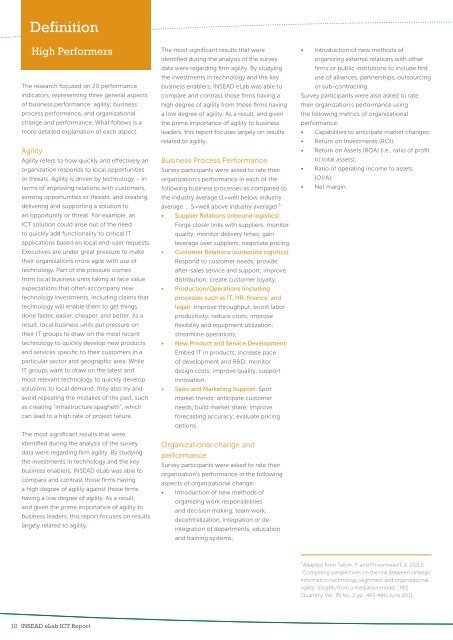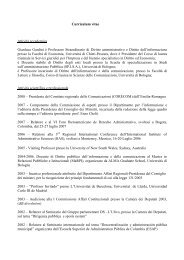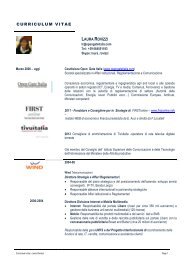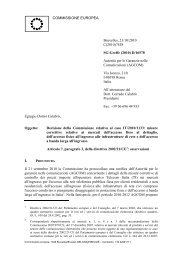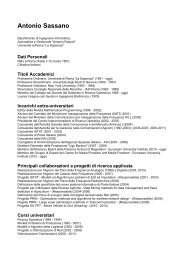Building Competitiveness and Business Performance with ICT
Building Competitiveness and Business Performance with ICT
Building Competitiveness and Business Performance with ICT
- No tags were found...
Create successful ePaper yourself
Turn your PDF publications into a flip-book with our unique Google optimized e-Paper software.
DefinitionHigh Performers• Introduction of new methods ofThe research focused on 20 performanceindicators, representing three general aspectsof business performance: agility; businessprocess performance, <strong>and</strong> organizationalchange <strong>and</strong> performance. What follows is amore detailed explanation of each aspect.AgilityAgility refers to how quickly <strong>and</strong> effectively anorganization responds to local opportunitiesor threats. Agility is driven by technology – interms of improving relations <strong>with</strong> customers,sensing opportunities or threats, <strong>and</strong> creating,delivering <strong>and</strong> supporting a solution toan opportunity or threat. For example, an<strong>ICT</strong> solution could arise out of the needto quickly add functionality to critical ITapplications based on local end-user requests.Executives are under great pressure to maketheir organizations more agile <strong>with</strong> use oftechnology. Part of the pressure comesfrom local business units taking at face valueexpectations that often accompany newtechnology investments, including claims thattechnology will enable them to get thingsdone faster, easier, cheaper, <strong>and</strong> better. As aresult, local business units put pressure ontheir IT groups to draw on the most recenttechnology to quickly develop new products<strong>and</strong> services specific to their customers in aparticular sector <strong>and</strong> geographic area. WhileIT groups want to draw on the latest <strong>and</strong>most relevant technology to quickly developsolutions to local dem<strong>and</strong>, they also try <strong>and</strong>avoid repeating the mistakes of the past, suchas creating “infrastructure spaghetti”, whichcan lead to a high rate of project failure.The most significant results that wereidentified during the analysis of the surveydata were regarding firm agility. By studyingthe investments in technology <strong>and</strong> the keybusiness enablers, INSEAD eLab was able tocompare <strong>and</strong> contrast those firms havinga high degree of agility against those firmshaving a low degree of agility. As a result,<strong>and</strong> given the prime importance of agility tobusiness leaders, this report focuses on resultslargely related to agility.The most significant results that wereidentified during the analysis of the surveydata were regarding firm agility. By studyingthe investments in technology <strong>and</strong> the keybusiness enablers, INSEAD eLab was able tocompare <strong>and</strong> contrast those firms having ahigh degree of agility from those firms havinga low degree of agility. As a result, <strong>and</strong> giventhe prime importance of agility to businessleaders, this report focuses largely on resultsrelated to agility.<strong>Business</strong> Process <strong>Performance</strong>Survey participants were asked to rate theirorganization’s performance in each of thefollowing business processes as compared tothe industry average (1=well below industryaverage ... 5=well above industry average). 5• Supplier Relations (inbound logistics):Forge closer links <strong>with</strong> suppliers; monitorquality; monitor delivery times; gainleverage over suppliers; negotiate pricing;• Customer Relations (outbound logistics):Respond to customer needs; provideafter-sales service <strong>and</strong> support; improvedistribution; create customer loyalty;• Production/Operations (includingprocesses such as IT, HR, finance, <strong>and</strong>legal): Improve throughput; boost laborproductivity; reduce costs; improveflexibility <strong>and</strong> equipment utilization;streamline operations;• New Product <strong>and</strong> Service Development:Embed IT in products; increase paceof development <strong>and</strong> R&D; monitordesign costs; improve quality; supportinnovation;• Sales <strong>and</strong> Marketing Support: Spotmarket trends; anticipate customerneeds; build market share; improveforecasting accuracy; evaluate pricingoptions.Organizational change <strong>and</strong>performanceSurvey participants were asked to rate theirorganization’s performance in the followingaspects of organizational change:• Introduction of new methods oforganizing work responsibilities<strong>and</strong> decision making, team work,decentralization, integration or deintegrationof departments, education<strong>and</strong> training systems;organizing external relations <strong>with</strong> otherfirms or public institutions to include firstuse of alliances, partnerships, outsourcingor sub-contracting.Survey participants were also asked to ratetheir organization’s performance usingthe following metrics of organizationalperformance.• Capabilities to anticipate market changes;• Return on Investments (ROI);• Return on Assets (ROA) (i.e., ratio of profitto total assets);• Ratio of operating income to assets(OI/A);• Net margin.5 Adapted from Tallon, P. <strong>and</strong> Pinsonneault, A. (2011).“Competing perspectives on the link between strategicinformation technology alignment <strong>and</strong> organizationalagility: Insights from a mediation model.” MISQuarterly Vol. 35 No. 2 pp. 463-486/June 201110 INSEAD eLab <strong>ICT</strong> Report


